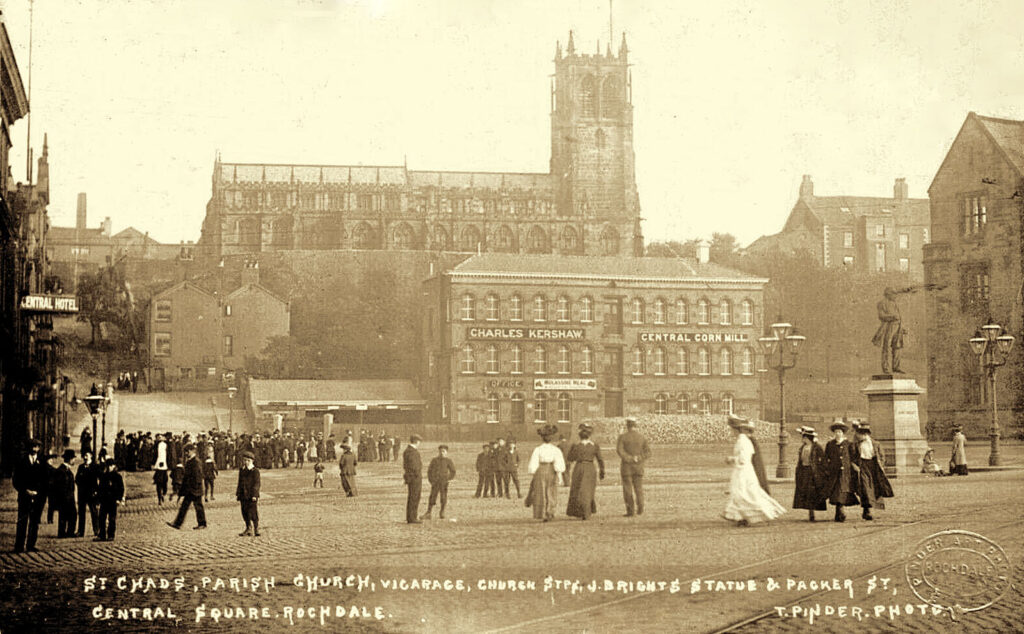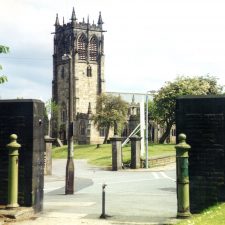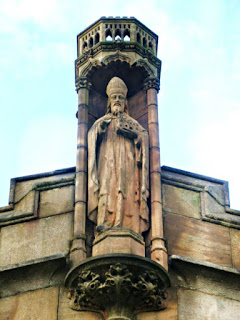Rochdale Parish Church

Almost every boundary set around a part of England may be identified as a parish and most parishes have their own consecrated parish church open for Christian worship and the pastoral care of the people within that boundary. The parish church in Rochdale is administered as the Church of St Chad, Chad being a 7th century churchman possibly coming from a family of Northumbrian nobility who had been a student at Lindisfarne and became Abbot of Lastingham and for a period, Bishop of York. Chad died in the year 672 and the town of Chadderton is most likely named after him.

As mother church in the parish of Rochdale, the earliest building of St Chad’s is a matter of debate. Certainly there was a church on the site overlooking the town of Recedham or Rachedale in either the late Saxon period or just after the Norman conquest, the mid 11th to early 12th centuries, although the date is open to question. What is recorded however is that in 1194 land was given by Adam de Spotland for religious purposes in order (as Wild in the 1970’s suggests) ‘to save his soul and that of his family.’ The current handsome gothic structure standing up on its lofty ridge is not exactly the one from the middle ages although the tower is reputedly the oldest part of the building.

The siting of the church has been the subject of the ‘fairy builders’ myth whereby on a number of occasions the stones and materials that had been assembled by the River Roch near Newgate where the church was supposed to be built, were mysteriously and at night re-gathered at the top of the hill where the church now stands. Eventually accepting this supernatural indication of its proper site required 124 church steps to be laid leading to the religious place. Less romantically, the real reason for the site would have been its prominent place near a raised earthwork which formed a nearby hill sometimes called a ‘castle’ which overlooked the valley and the Roch. Notwithstanding any supernatural beginnings which would have almost certainly have been discredited by him, the first vicar of the church of St Chad was Geoffrey de Lacey, Dean of Whalley in 1194. On Geoffrey’s death Roger de Lacey gave the church to the Cistercian brothers of Stanlow who later moved to Whalley Abbey. Thereafter the vicars were Sir William de Dumplinton in 1238, John de Blackburne in 1250 and Roger de Marland in 1277. Structurally the building has been changed over the centuries although Wild in his short book on the subject suggests that the remains of a Saxon wall were found in the north west corner of the churchyard as evidence of an early church. However, re-building was carried out between 1470 and 1480 and, as a gift from Robert Belfield, extensions added around 1530. It would seem that the building became dilapidated in the 18th century to such an extent that Lord Byron paid for general renovation of its walls and the roof. In the 19th century a clock set in the tower was removed and more recently Canon Nightingale ordered work costing £40,000 carried out in 1952. Architecturally there are interesting external features to the church such as the West door which has twin angels (one holding a harp the other a timpani), the carvings of Queen Victoria and Prince Albert on the tower as well as three fish representing the roaches in the River Roch. Erected in 1873 the current porch replaced an older one ordered by Henry Pigot the vicar in 1700 over which stands a fine carving of St Chad holding up a church with angels to either side of him. There are different entrances to the churchyard leading to the Parish Church, one is by climbing the 127 steps, another by the Lychgate and stocks and a third by the western wall (a private entrance). Interestingly, this high western wall was erected by Dr Tunstall vicar between 1757-62 allegedly to prevent his daughters playing with the local children for fear that ‘they might acquire a northern accent.’ In its interior in 1845 the church was known to be heated by steam pipes. In the 19th century Dr Molesworth told Dr Dearden, both important townsmen, that people were feeling the cold in church to which Dearden replied ‘Tell them to drink a quart of ale before they come to church and they will noan be starved.’ Looking up from their pews the cold congregation would have seen a memorial window in the West of the church designed by Burne-Jones and dedicated to the parents of Clement Royd with glass by William Morris. One amusing aside concerning the church is an entry in the churchwarden’s records of 1643 identifying expenses for ‘three hedgehogs,’ these being bought to keep the church free of insects in the rushes which in those days were laid to carpet and warm the interior of the building.